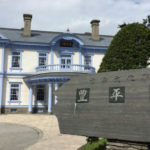目次

江差町の横山家は昔の商家。
横山家は、初代の時代から漁業、商業、廻船問屋を営み、

■ここが駐車場です。

■町もすっきりしてる。

■町の案内板です。

■さすがの指定文化財の商家です。

■にしんそば屋さんを営業中です。

■前の通りもすっきりしている感じです。
横山家は指定文化財でありますが、にしんそばもやってます。
今から約50年前に考案されたという北海道風の

■にしんそば屋さんの入口です。

■そばを頂く場所はこの座敷です。

■床の間もあります。昔の民家です。

■夏の民家の風景です。

■にしんそば おいしかったです。値段が少々高かった、1000円です!
江差町と石狩挽歌。
母屋と四番蔵には、ニシン漁全盛期に使われていた

■年代物がたくさんあります。

■玄関の座敷です。

■中の土間がずっと仲間で続いています。

■でっかい金庫ですか?蔵ですか。扉が太い。

■昔のにしん漁の道具がずら~と並んでます。

■昔の江差の風景でしょうか・・・。

■屏風がご立派です。

■なんかお宝が出てきそうなふいいんきですが・・・。

■ひよしまる・みょうじんまる・ちょうえいまる でしょうか?
“Yokoyamaya” in Esashi-cho, Hokkaido This area is famous for “herring”. A wealthy merchant.
The Yokoyama family in Esashi Town was an old merchant house.
The Yokoyama family is a merchant family with a history of over 200 years, running fisheries, commerce, and shipping wholesalers since the first generation. The current building was built about 160 years ago. It is a wooden house that does not use nails and has an earthquake-resistant structure. It is now a designated cultural property of Hokkaido. Inside, tools from the fishing era and daily necessities from the Edo period were displayed, including the storehouse, which was quite impressive. As for the town itself, there’s nothing quite like it, or rather, he’s a neat town with few cars, so he can come and go relatively freely, and on sunny days, the sea is close, so I think he’s a good mate.
The Yokoyama family is a designated cultural property, but they also serve herring soba.
Hokkaido-style herring soba, which was invented about 50 years ago, is also famous. I had “herring soba”. Kanto-style dashi soup looks a little thick, but he was light. As a Kansai person, he was a little dissatisfied with the simple dashi soup, but isn’t it like this? He felt that the dried herring was a little lacking in sweetness, but what do you think?
Esashi Town and Ishikari Banka.
In the main building and the fourth storehouse, there are displays of everyday tools used during the heyday of herring fishing, and you can learn about the life of merchants at that time. The scenery is beautiful and the climate is perfect. This season is! It seems that the wind is strong around here and there is little snow. The snow is blown by the strong wind, and it seems that there really isn’t much snow. Esashi means a cape in the Ainu language, and the town got its name from the topography. There is a famous Uta, but “Ishikari Banka”. This is good, isn’t it? “Where did the herring go after that?” It is true that the herring stopped coming around a long time ago, and it became impossible to pick it. But Esashi town was a really nice town. I want to live there!



